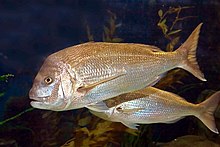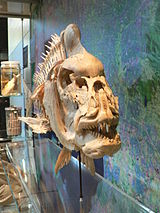
The bluefish is the only extant species of the family Pomatomidae. It is a marine pelagic fish found around the world in temperate and subtropical waters, except for the northern Pacific Ocean. Bluefish are known as tailor in Australia and New Zealand, elf and shad in South Africa. It is a popular gamefish and food fish.
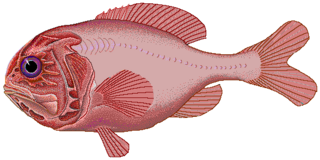
The orange roughy, also known as the red roughy, slimehead and deep sea perch, is a relatively large deep-sea fish belonging to the slimehead family (Trachichthyidae). The UK Marine Conservation Society has categorized orange roughy as "vulnerable to exploitation". It is found in 3 to 9 °C, deep waters of the Western Pacific Ocean, eastern Atlantic Ocean, Indo-Pacific, and in the eastern Pacific off Chile. The orange roughy is notable for its extraordinary lifespan, attaining over 200 years. It is important to commercial deep-trawl fisheries. The fish is a bright, brick-red color, fading to a yellowish-orange after death.

Arripis is a genus of marine fishes from Australia and New Zealand, known as Australian salmon, kahawai and Australian herring. They are the only members of the family Arripidae. Despite the common name, Australian salmon are not related to the salmon family Salmonidae of the Northern Hemisphere, just as Australian herring are not related to herring of the Northern Hemisphere, but belong to the order Perciformes of perch-like fishes. Australian salmon were named so by early European settlers after their superficial resemblance to the salmoniform fishes.

The Poor Knights Islands Marine Reserve is a protected area off the coast of the North Island of New Zealand. The reserve, established in 1981 and covering an area of 1,890 ha, is administered by the Department of Conservation. It surrounds the Poor Knights Islands and adjacent rock stacks Sugarloaf Rock and High Peak Rocks. It is one of the world's ten most popular sites for scuba diving. with dive trips regularly leaving from the town of Tutukaka.
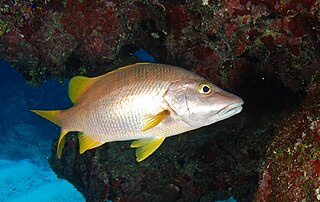
The schoolmaster snapper, is a species of marine ray-finned fish, a snapper belonging to the family Lutjanidae. It is found in the western Atlantic Ocean. Like other snapper species, it is a popular food fish.

The King George whiting, also known as the spotted whiting or spotted sillago, is a coastal marine fish of the smelt-whitings family Sillaginidae. The King George whiting is endemic to Australia, inhabiting the south coast of the country from Jurien Bay, Western Australia to Botany Bay, New South Wales in the east. The King George whiting is the only member of the genus Sillaginodes and the largest member of the smelt-whiting family Sillaginidae, growing to a length of 80 cm and 4.8 kg in weight. The species is readily distinguishable from other Australian whitings by its unique pattern of spots, as well as its highly elongate shape. King George whiting are often found in bays and protected waterways over sand and seagrass beds, also venturing out onto deep continental shelf reefs during adulthood. The species is a benthic carnivore, consuming a variety of crustaceans, polychaete worms, molluscs and fish. The King George whiting forms the basis of one of southern Australia's most important commercial fisheries, reportedly worth over five million Australian dollars per year. The species is also heavily targeted by recreational anglers, who value the whiting for its sporting and eating qualities.

The red porgy, also known as the common seabream or Couch's bream, is a species of marine ray-finned fish in the family Sparidae. It is found in shallow waters on either side of the Atlantic Ocean, being present on the western coast of Europe and the Mediterranean Sea as well as the eastern coasts of North and South America and the Caribbean Sea. It feeds on or near the seabed and most individuals start life as females and later change sex to males.

Pagrus is a genus of marine ray-finned fishes belonging to the family Sparidae, which includes the seabreams and porgies. These fishes are found in the Western Pacific Ocean, Atlantic Ocean and Mediterranean Sea. They are esteemed food fishes which are targeted by commercial fisheries and are grown in aquaculture.

The leopard coral grouper, also known as the common coral trout, leopard coral trout, blue-dotted coral grouper or spotted coral grouper, is a species of marine ray-finned fish, a grouper from the subfamily Epinephelinae which is part of the family Serranidae, which also includes the anthias and sea basses. It is found in the Western Pacific Ocean.

The vermilion snapper, the clubhead snapper, night snapper, Brian's red fish or beeliner is a species of marine ray-finned fish, a snapper belonging to the family Lutjanidae. It is native to the western Atlantic Ocean.

The black bream, also commonly known as the southern black bream, southern bream and blue-nosed bream, is a species of anadromous ray-finned fish of the porgy family Sparidae. A deep-bodied fish, it is occasionally confused with other similar species that occur within its range, but is generally distinguished from these species by a lack of yellow ventral and anal fins. Southern black bream are endemic to the southern coasts of Australia from Shark Bay in Western Australia to Ulladulla, New South Wales, as well as Tasmania.

Lutjanus agennes, the African red snapper, Guinean snapper or African cubera snapper, is a species of marine ray-finned fish belonging to the family Lutjanidae, the snappers. It is native to the coastal Atlantic waters of Africa.
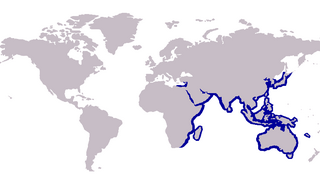
Smelt-whiting is the common name for various species of the family Sillaginidae. The Sillaginidae are distributed throughout the Indo-Pacific region, ranging from the west coast of Africa to Japan and Taiwan in the east, as well occupying as a number of small islands including New Caledonia in the Pacific Ocean. Well known members of this family include King George whiting, Japanese whiting, northern whiting, sand whiting and school whiting.

Porgy is the common name in Australia for any fish which belongs to the family Sparidae. They are also called bream. Porgies live in shallow temperate marine waters and are bottom-dwelling carnivores. Most species possess grinding, molar-like teeth. They are often good eating fish, particularly the gilt-head bream and the dentex.

The Chilean jack mackerel, sometimes called the Inca scad or Peruvian jack mackerel, is a species of jack mackerel in the genus Trachurus of the family Carangidae. Since the 1970s, it has become one of the world's more important commercial fish species. High volumes have been harvested, but the fishery may now be in danger of collapsing.

Lutjanus carponotatus, the Spanish flag snapper, stripey snapper, dusky-striped sea-perch, gold-banded sea perch, gold-stripe sea-perch, striped seaperch or stripey seaperch, is a species marine ray-finned fish, a snapper belonging to the family Lutjanidae. It is native to the western Pacific and Indian Oceans, from India to northern Australia.
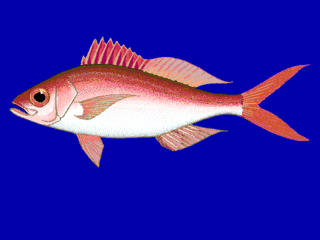
The queen snapper, also known as the night snapper or brim snapper, is a species of ray-finned fish, a snapper belonging to the family Lutjanidae. It is native to the western Atlantic Ocean, and is the only species in the genus Etelis found outside the Indo-Pacific region.

The African brown snapper is a species of marine ray-finned fish, a snapper belonging to the family Lutjanidae. It is native to the eastern Atlantic Ocean off the coast of West Africa.
Metapenaeus bennettae is a species of small prawn found in eastern Australia, where it is called the greentail or greasyback prawn.
